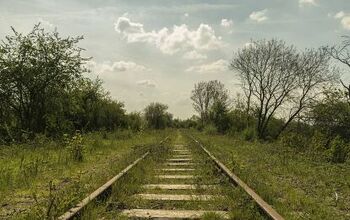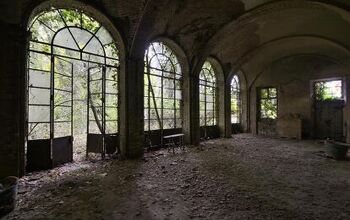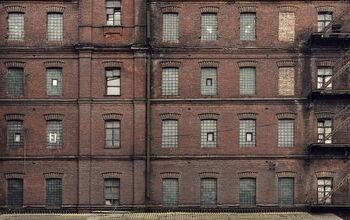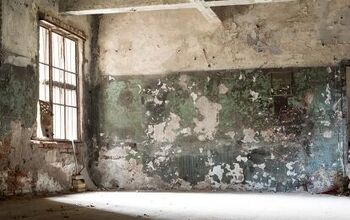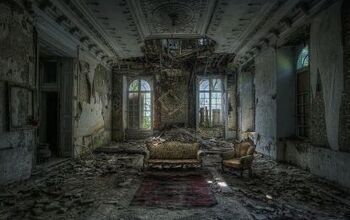Top 13 Abandoned Places In Utah

Ask anyone who has a working knowledge of American paranormal lore, and they’ll tell you that there is something wrong with Utah. The state has a deep history of everything paranormal—ghosts, ghouls, skinwalkers, as well as UFOs. It’s a place where anything can happen, and it often does. That’s why there are so many strange abandoned places in Utah.
Utah is a state that holds a staggering number of abandoned places that are filled with lore, legends, and fascinating architecture. Some of the more interesting places include:
- Skinwalker Ranch
- Old Blue Mountain Ski Resort
- The 17 Room Ruin
- Thistle
- Harold Mill
- Bellshire Hospital
- The Old Arrowhead Swimming Resort
- Cottonwood Paper Mill
The paranormal lore of the area isn’t the only reason why you might want to check out Utah. The truth is that this region has a lot to offer in terms of history, too.
The Most Interesting Abandoned Places In Utah
Utah has a lot of crazy places that people love to explore and discuss. These are the most commonly cited.
1. Skinwalker Ranch – Ballard
Also known as the Sherman Ranch or Gorman Ranch, the Skinwalker Ranch became a famous abandoned property after the book Hunt for the Skinwalker was published. According to eyewitness accounts, the ranch itself boasts one of the largest collections of paranormal activity on the earth. Unfortunately, it’s not of the friendly type.
Ranchers who lived here experienced countless animal mutilations, terrifying shadow figures at the foot of their beds, strange portals to other worlds, and more. After trying everything possible to keep things normal, family after family fled. The ranch is now a hotbed of paranormal researchers trying to figure out what the heck is going on. So far, no luck.
2. Old Blue Mountain Ski Resort – Moab
Utah is filled to the brim with ski resorts, but not all of them tend to work out. One of the most notorious ski resorts to have failed is Old Blue Mountain. At one point, the ski resort was slated to become the next big thing. However, the extremely remote area of the resort made it less-than-stellar. It quickly became overlooked, despite the beautiful views.
The Old Blue Mountain still has a fair amount of its buildings and equipment. You can still check out the ski lift, the old 70s-style ski lodge, and a lot of the parking lots too. This is all the more impressive when you realize that Old Blue Mountain was one of the very first ski resorts to have a real ski lift in the state.
3. The 17 Room Ruin – Bluff
It’s important to remember that Utah wasn’t always a part of America. It was home to the Pueblo Indian tribe, and prior to settlers committing acts of genocide, they had amazing civilizations and cities. One of the most culturally significant abandoned places that you can go dealing with this history.
Off near the area known as Bluff, you can check out a 17-room Pueblo house. Not much is known about the settlement or what purpose it served. Archeologists believe that some of the rooms were two stories tall. This gave the owners a good bird’s eye view of their home.
4. Thistle – Thistle
Most of the abandoned ghost towns in Utah were once booming mining towns, but not this one. Thistle started out as one of the many railroad towns that the area had. The town was highly successful and would have continued to be a favorite place to be for many tourists had a giant flood not wiped out the city in 1983.
The flood itself was sparked by a landslide, and while the town could have been rebuilt, it never was. As of today, visitors have the chance to check out the ruins of the structures that once housed people. The town itself never held too many people by today’s standards, but back in the day, it peaked at 500. That was once a pretty big number for the West.
5. Harold Mill – Goshen
If you’re a fan of industrial grit, then you might find the mill right outside of Goshen to be a particularly fascinating abandoned place. The mill itself was used to process many of the metals obtained by miners in and around the community. Some of their top metals included gold, silver, copper, as well as less ‘blinged out’ picks like aluminum.
Unfortunately, the gold boom and bust meant that Harold Mill eventually went out of business. After all, you can’t really have any business if the supplies that you’re purifying are no longer being made. Harold Mill shuttered in 1925. Since then it became one of the biggest graffiti hotspots in all of Utah. It’s kind of an artist’s paradise, even if it’s creepy.
This mill was added to the National Registry of Historic Places in 1978.
6. Bellshire Hospital – Ogden
Bellshire Hospital is one of those venues that everyone (rightfully) presumes will be haunted. The hospital focused on the mentally ill, and truthfully, the stories about patient abuse here are absolutely shocking. One of the most pervasive stories involves a psychiatrist who experimented on residents, torturing them for his own personal satisfaction.
Truthfully, the death rates in this hospital alone would be a reason to believe it’s haunted. When the hospital shuttered, rumors of it being a haunted or even cursed area quickly came to life. Though the area briefly served as a haunted house attraction in the early 2000s, the area shuttered. It seems like it was just a bit too real for the actors there.
7. Old Arrowhead Swimming Resort – Benjamin
It’s important to remember that pools were fairly rare about a century ago, especially in states like Utah. That’s why one business owner created a resort that had the main attraction as a swimming resort. During its heyday, Old Arrowhead was a true gem of the west. It was the place where people who were able to afford the finer things in life would go to.
Old Arrowhead eventually fell into disarray when several towns nearby ended up “dying out.” Unfortunately, tragedy also struck the area when a six-year-old boy drowned in the pool. Shortly after, the pool was filled in and the resort was done. Today, people claim to see a disembodied shadow of a boy and green mist around the area.
8. The Cottonwood Papermill – Cottonwood Heights
At first glance, you would be forgiven for assuming that you’re staring at a photo of an abandoned castle in Ireland. However, you’d still be wrong. This photo is of the Cottonwood Paper Mill, right in the middle of Salt Lake County, Utah. The paper mill itself had a promising beginning back when it was constructed in 1883.
Unfortunately, this palatial castle-factory’s life got cut short when a massive fire devastated the factory in 1893. Partly due to the loss of life the pace suffered, and partly due to the high cost of repairs, the area never fully recovered. The factory closed up, and its remains can be seen right by the side of the road.
9. Delta Solar Ruins – Hinckley
Delta Solar was once supposed to be the new, green way to make energy in Utah. Unfortunately, it was never actually going to head anywhere. The truth is that the company was actually made as a tax haven for several wealthy criminals, and was supposed to be a shell company. But, they had to do something to make the place look more legit.
The solar farm they made was…special. It was more of a “Burning Man” art setup than anything that had to do with actually making energy. The ruins quickly were abandoned after the people behind the company were placed under arrest. Nowadays, you can take a look at the area and get a better idea of how massive this sham of a project really was.
This is the most recently abandoned structure on this list. The raid by the FBI only happened a couple of years ago during the Trump administration. So, it’s still relatively fresh.
10. Thistle
Thistle, a little town on the Denver and Rio Grande Western Railroad, was formerly a major halt. The town included a school, a bar, and several eateries, and it had a population of up to 650 people. As the steam engines passed through the canyon, the train depot provided maintenance.
Trains no longer stopped in Thistle once the railroad switched from steam to diesel locomotives, and the town’s population gradually declined until only 22 dwellings were occupied. Many of the individuals who remained had lived in the village for decades and adored it.
However, in 1983, after a spring of severe rain in Utah, a landslide blocked the Spanish Fork river, resulting in a major flood that destroyed the rail line and wiped away Thistle.
11. Tintic Standard Reduction Mill, Goshen
The Tintic Mill is a relic of Utah’s mining past. It was built primarily to process silver in the 1920s. It was only in operation for five years, yet it left a lasting impression.
According to samples taken by the Utah Department of Environmental Quality in 2002, the mill managed to poison the surrounding soil and water with lead and arsenic in that short time.
In 1978, the mill was listed on the National Register of Historic Places. In 1986, the company was sold to DWR. The Goshen Warm Springs Wildlife Management Area now owns the mill.
Come to Tintic Mill to see early twentieth-century industrialism nestled in a wildlife management area. Stay to get sick from lead and arsenic and get a trespassing ticket from a state official.
12. Grist Mill 327 East 200 North
The Box Elder Grist Mill, also known as the Flouring Mill, was Brigham City’s first industrial structure. Frederick Kesler, one of the most influential architects in the construction of Utah’s pioneer mills, designed it.
The mill was supposed to be the northeast corner of a rock wall that would surround the settlement. The mill was utilized as a fort with armed guards positioned in the higher floors to protect townsfolk, and the wall was built to protect against hostile Indians.
The mill was finished in 1856, but it didn’t start functioning until 1857, when the local wheat crop provided enough to feed the mill. Flour production was critical to the small community’s growth.
During the cooperative time, Lorenzo Snow held management of the mill, although the property was never sold to the association.
13. Hotel In Modena Utah
Modena is now mostly abandoned or vacant; a few residents still live in the residential area, but the ancient business sector is deserted. The train continues to pass through Modena, but it does not stop.
The Merchandise & Hotel building of Brigham Lund dominates the townscape. A false-fronted shop next to Lund’s Hotel on the dirt main street looks like it could be a still from any 1950s “Wild West” film.
Modena is only a few feet from the train lines, so being a guest at the hotel when the steam locomotive rolled into town, wailing its whistle more than a Century ago must have been quite an event.
Related Questions
How many abandoned mines are there in Utah?
Utah’s history is hard to track at times, especially when it came to the days of pioneers and the gold rush. As a result, no one knows how many mines were used in the state during its history.What we can tell you, though, is a ballpark estimate. The most common range people give for people who are curious is between 8,000 to 12,000 abandoned mines.This has a lot of implications if you think about it. Because no one knows the full number, you might end up finding a missing mine that has been untouched for over 100 years.
Is Utah the Wild West?
When people think of the “Wild West,” it refers to both a time and place. The days of the Wild West happened when the laws were lawless and where there were tons of wide, open spaces.It also refers to the part of the country that had a heavy influence of cowboy culture that colored everything. There is no part of America that still has the Wild West lawlessness, but Utah still has a deep influence from the days of cowboys.
What are Utah’s biggest industries?
While gold mining has gone the way of the dodo, this state still has a huge coal mining industry. Other industries include cattle ranching, MLMs, and salt production.Other major industries include government services, call centers, and religion-based industries. With that said, virtually any industry that you can imagine will be found in Utah in one form or another.

Ossiana Tepfenhart is an expert writer, focusing on interior design and general home tips. Writing is her life, and it's what she does best. Her interests include art and real estate investments.
More by Ossiana Tepfenhart










